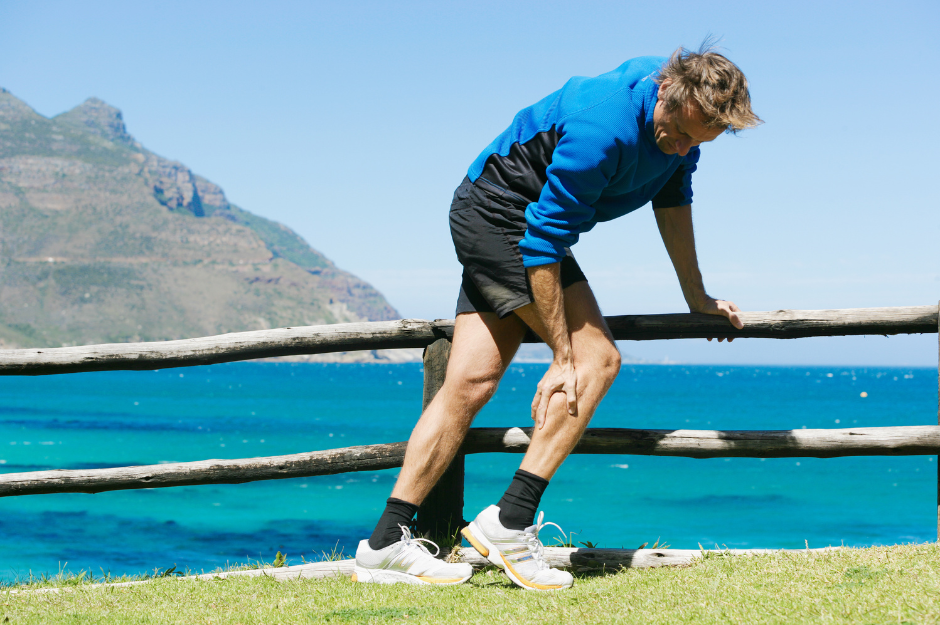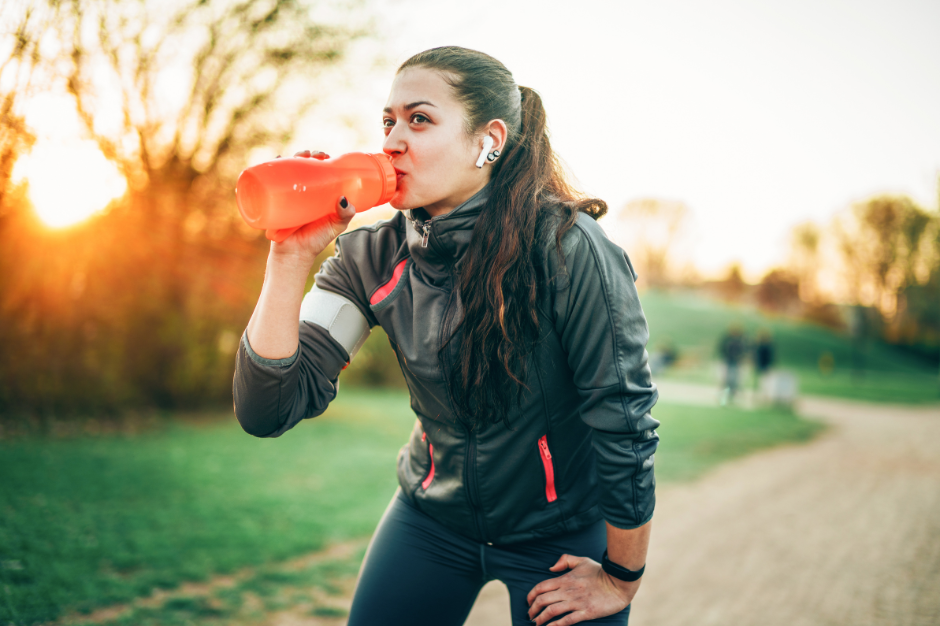

Start ‘Em Young: Prevention of Bone Stress Injuries in Athletes
Dr. Emily Kraus and obstacle racing world champion Amelia Boone team up to share actionable steps to prevent bone stress injuries, especially in the adolescent years.
March 13, 2024

Emily Kraus, MD
Dr. Emily Kraus is a clinical assistant professor at Stanford Children’s Orthopedic and Sports Medicine Center. Dr. Kraus is also the director of the Female Athlete Science and Translational Research (FASTR) Program, supported by the Wu Tsai Human Performance Alliance.

Amelia Boone
Amelia Boone is a 4X obstacle racing world champion, ultra runner, attorney, and eating disorder awareness advocate. She has stood on more than 50 podiums and achieved 30 victories in obstacle racing. As she likes to say, she is the ultimate “weekend warrior.”
Amelia Boone is a 4-time world champion of obstacle racing and ultramarathoner, whose notable athletic accomplishments include being a 3-time winner of the World’s Toughest Mudder and 3-time Death Race Finisher. On top of all this, she is a full-time corporate attorney. And yet, even the most extraordinary athletes are not impervious to the risks inherent in their pursuits. One such concern that affects athletes across many disciplines is bone stress injuries (BSIs) – a formidable adversary that can hinder performance and sideline careers.
Boone was at the top of her game when the setbacks hit again and again. She suffered six BSIs in three years: a stress fracture in her femur, a sacral stress fracture, a fully displaced second metatarsal, and three different stress fractures in her heel.
“I told myself I didn’t have a problem – that I was performing at such a high level, there couldn’t have been an issue,’” said Boone. “Then the wheels fell off and bones started breaking. Your body can survive until it can no longer survive. That’s the point when I realized, ‘I need to address this and take steps to get healthy.’”
Her road to recovery would ultimately land her as an advocate for bone health and injury prevention. Boone turned to Dr. Emily Kraus for advice, and so we too talked with Dr. Kraus about the actionable steps coaches and athletes can take to build a strong skeletal framework that works for them, not against them.
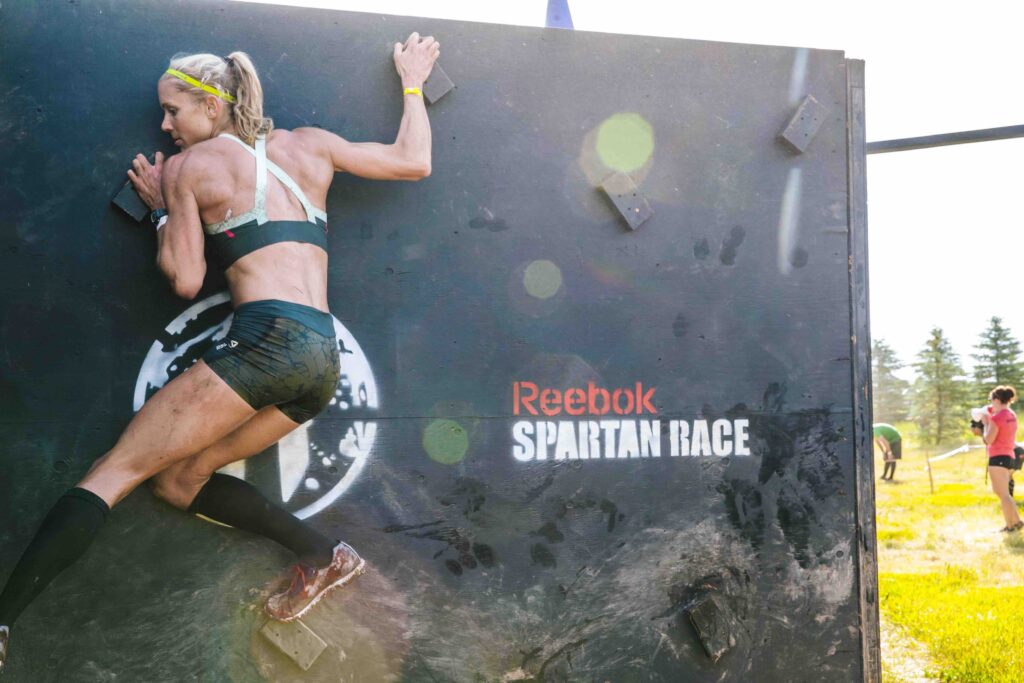
Amelia Boone during an obstacle race on a traverse wall. Image courtesy of Boone.
Adolescence is Prime Time for Bone Health
In the realm of human health, bones often take a backstage role compared to organs like the heart or lungs. But beneath the rigid facade of bone lies a fascinating world of dynamic living tissue that continuously adapts to various stressors. Bones respond to mechanical stimuli by converting mechanical stress into biochemical signals that shape their structure and strength; just like muscles get stronger when they are loaded, so too do bones.
While mechanical stress is essential for maintaining healthy bones, an imbalance between mechanical load and the bone’s capacity to adapt can lead to detrimental effects. On a cellular level, this is when the osteoblast (or bone-building) cell activity lags behind osteoclast (bone breakdown) cell activity, resulting in bones that are persistently loaded and at risk for injury.1,2
The repetitive stress and impact placed on bones during intense training can lead to micro-damage, ultimately compromising the integrity of the skeletal structure. According to Dr. Kraus, there are ways to mitigate the risk factors for BSIs, especially in adolescents.
During adolescence, the human body undergoes a phase of development characterized by rapid growth and various physiological changes, beginning with the onset of puberty. One crucial aspect of this period is bone-modeling, where the foundation for skeletal strength is established.
“At least 90% of peak bone mass is attained by age 18, which highlights the importance of optimizing nutrition and physical activity from a young age,”3,4 said Dr. Kraus. “Later in life, it’s far more difficult to make such significant improvements in bone mass.”

Training Tip
Dr. Kraus recommends athletes increase training distance and intensity gradually, avoiding spikes in mileage or intensity, with a focus on increasing volume (mileage or duration) over intensity (speed or power) to decrease BSI risk.
Bone stress injuries commonly happen in bones that bear significant loads, such as the lower extremities. The long bones of the leg (tibia and fibula) and the foot (metatarsals) are particularly susceptible. The specific location of the injury depends on how the skeleton is subjected to loads, which varies depending on the physical activity of the athlete.2
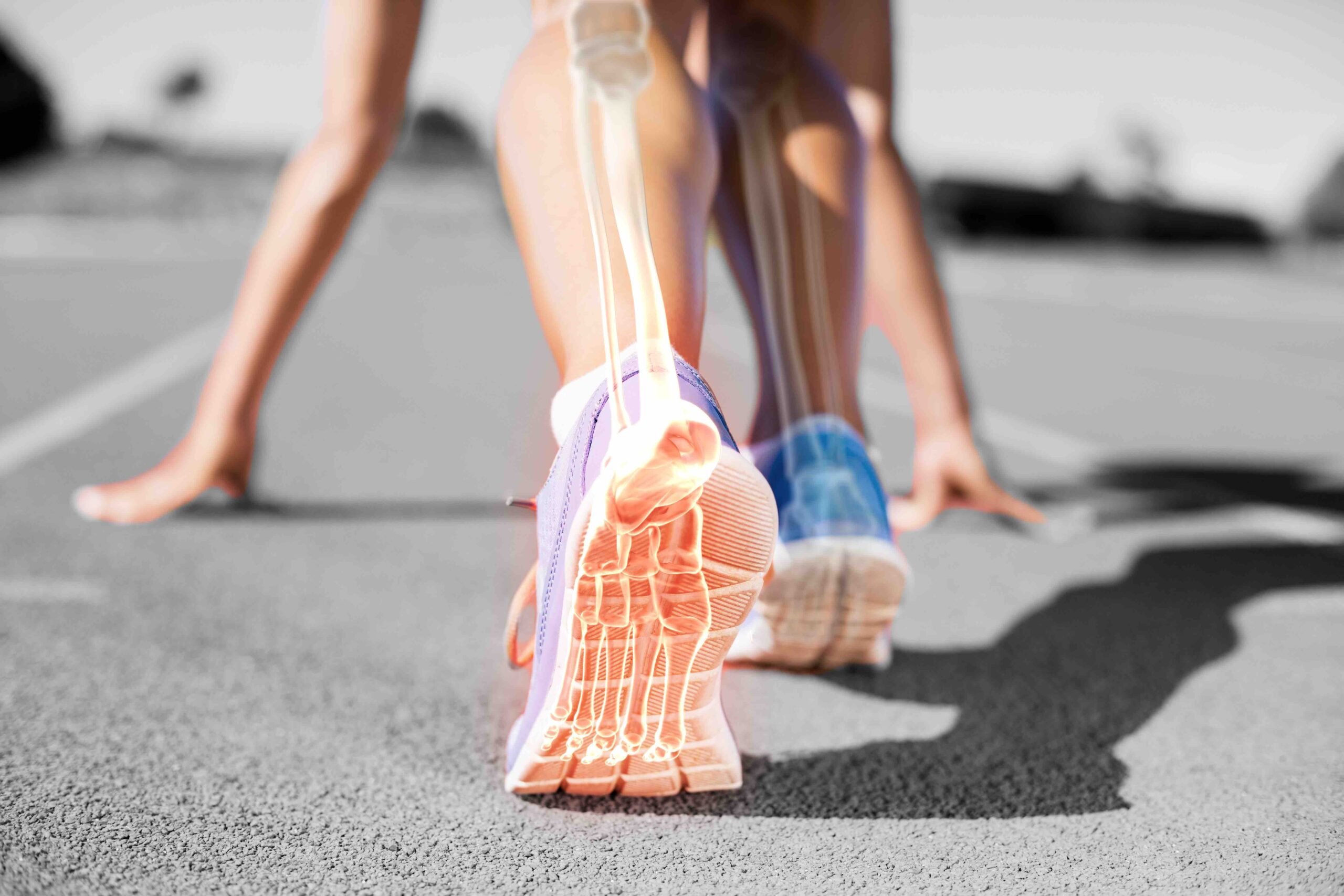
Strong bones are crucial for sports. Adobe Free images/WaveBreakMediaMicro
What About Strength Training and Calcium Supplements?
Strength training has the potential to benefit overall bone health, especially in runners at risk for BSIs, but Dr. Kraus notes that more prospective research to test specific strength training interventions in those at risk are needed in this area; most of the studies demonstrating how strength training may reduce BSIs are retrospective in nature.

What's the difference between retrospective and prospective studies?
Retrospective studies analyze past data, but they come with a catch – they are susceptible to biases such as who is included in the study (selection bias) and inaccurate recall. Prospective studies, on the other hand, involve observing participants over time and collecting data as events unfold. This design allows for a more controlled and systematic approach in determining the impact of an intervention, but can require a large number of participants and become impractical.
Taking a calcium supplement may not be the answer either. Insufficient calcium intake is just one of many factors that can lead to low-bone mineral density or a BSI, but it’s often not the main reason.
“We need to think about the influence of nutrition (e.g., in conditions like Relative Energy Deficiency in Sport, vitamin D deficiency), training, genetics, medical conditions (thyroid dysfunction, Celiac disease, etc.), and medications (e.g., chronic corticosteroid use) that can all influence bone health,” said Dr. Kraus.
Nutrition and Boone’s Bone Health Journey
“I was diagnosed with an eating disorder when I was 15 and I was very, very sick for most of high school and college and in and out of treatment facilities,” said Boone. “Though I thought I had reached a good state of recovery, my eating disorder started creeping back in my early 30s and I relapsed hard.”

Amelia Boone competes in World’s Toughest Mudder 2012. Wikimedia Commons
“For my femoral stress fracture in 2016, I was on crutches for three months. Once I got back to running within three weeks I had a sacral stress fracture,” said Boone. “At that point, it hit me hard that two in a row meant there was a huge issue, which I wanted to fix but I just couldn’t get myself to do it on my own. Then it was just this cycle over the next three years of getting a stress fracture every six months. It’s hard to ignore that pattern, especially when I was not running high mileage at all.”
In her blog, Boone confessed she had to accept that high mileage is likely not in the cards for her anymore. “Too many years of starving my body has taken a toll on my bones (though, encouragingly, my bone density is the highest it’s ever been. But at age 37, there’s no “building” more, so I’ve got to retain what I have).”
For adolescent girls and women, irregular or missed periods can serve as a crucial warning sign for low energy availability (LEA) and impaired bone remodeling. LEA occurs when there is insufficient energy intake to support the body’s physiological functions. When the body perceives a lack of energy availability, essential bodily functions are prioritized and resources are diverted away from non-essential processes such as menstrual cycle regulation. Consequently, irregular or absent periods, known as amenorrhea, may manifest. Apart from its impact on reproductive health, LEA can also have detrimental effects on bone remodeling. Insufficient energy intake inhibits the body’s ability to rebuild and maintain bone density effectively, leading to an increased risk of stress fractures and osteoporosis.

Training Tip
“Fuel enough always. Problematic low energy availability has consistently been shown to be harmful for bones and the entire body,” said Dr. Kraus.
What Sport You Play Matters
The sport an athlete chooses to participate in can have a significant impact on their bone health. Some sports are more prone to bone stress injuries. A study has shown that collegiate athletes involved in high impact, repetitive load sports like cross country, gymnastics, and track and field tend to have higher rates of BSIs.5
“We also see higher BSI rates in sports that emphasize leanness, which can result in athletes intentionally or unintentionally restricting their food intake,” said Dr. Kraus.
The location of these BSIs can vary depending on the sport. Cross country runners commonly experience injuries in the tibia (also known as the shin in the lower leg),5 while ballet dancers often face metatarsal injuries in the foot.6 Gymnasts may encounter spine-related BSIs known as “pars defects,” and rowers are at a higher risk of rib BSIs.2
Interestingly, sports involving multi-directional patterns, such as basketball, volleyball, soccer, and lacrosse, have shown positive effects on bone health. Athletes engaged in these sports tend to have stronger bones, which potentially makes them more resistant to BSIs.
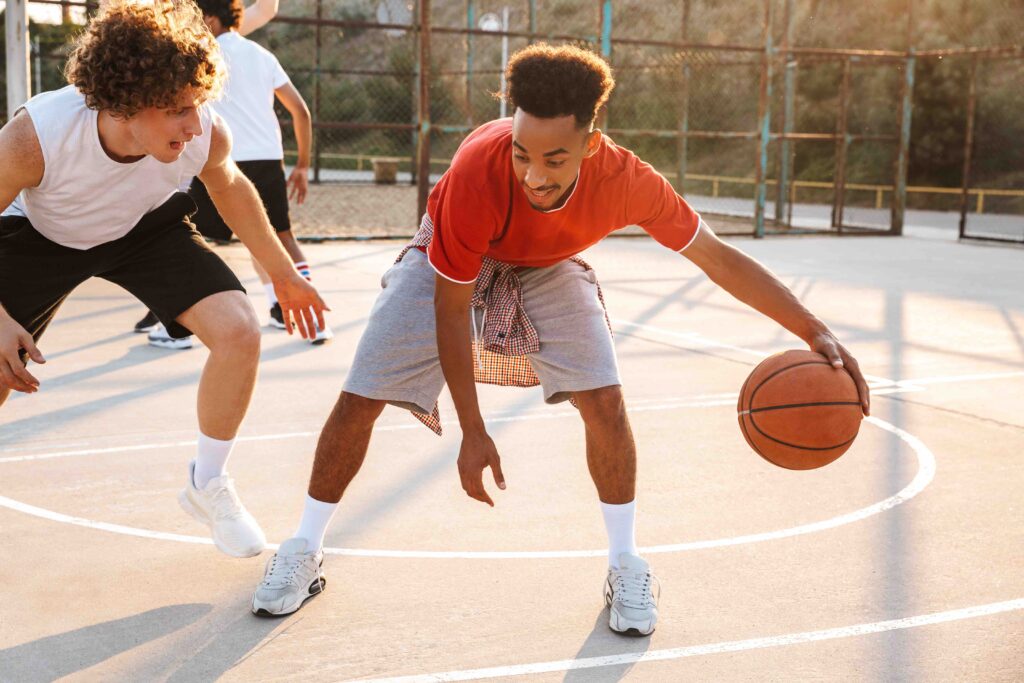
Basketball requires multi-directional movements that encourage strong bone properties. Adobe free photos/Drobot Dean

Training Tip
Variety is the spice of life — and healthy bones. Sports requiring moving and jumping in multi-directional patterns (like basketball, volleyball, soccer, and lacrosse) should be encouraged during growth. Adolescents and young adult men and women who participate in these sports exhibit stronger bone properties than low-impact sports or no sports at all, and may be more resistant to BSIs.7,8,9
Ultramarathon runners, on the other hand, may be at a particular risk of BSIs. Dr. Kraus and colleagues conducted a 2-year study on 123 participants of the Western States Ultramarathon (83 males, 40 females) and found that 21.8% of men and 35.7% of women had a history of one or more BSIs.10 The study highlights the importance of bone health education for both men and women.
And while most stress fractures occur in the lower extremities, the risk can vary depending on the population. Athletes who bear weights with their upper bodies, such as weightlifters, rowers, volleyball players, gymnasts, and overhead athletes, are also susceptible to stress fractures. In these cases, the fractures typically occur in the ribs and humerus (the bone in the upper arm).1
Yet inspiring young athletes to think about prevention – not just performance results – is no easy task, especially considering the competitive nature of many sports programs. Young athletes may perceive any time spent on preventive exercises or nutrition as detracting from their competitive edge.
However, if your ultimate goal is to achieve long-lasting peak performance, then prioritizing the maintenance of a robust skeletal framework is key.
Get Deeply Researched Insights on Human Performance
Join our mailing list to get actionable performance tips and nuanced explanations of the science.

Flash Q&A with Dr. Emily Kraus
What is one misconception about bone health you’d like to debunk?
One misconception that is finally getting debunked is that oral contraceptive pills (OCPs) help improve bone health and improve bone mineral density. Research has found that OCPs have little to no effect on improving bone mineral density or reducing fracture risk.11
Alternatively, a transdermal estrogen patch with cyclic oral progesterone has been shown to improve bone mineral density and bone microarchitecture in young female athletes with functional hypothalamic amenorrhea.12,13 I want to be clear that transdermal estrogen is not our first line approach for optimizing bone health in female athletes, and we make efforts to address problematic low energy availability through optimal nutrition and fueling practices. It’s also important to note that transdermal estrogen is not a form of birth control so athletes who are on transdermal estrogen will need to use some other form of contraception, such as an intrauterine device.
What sport do you enjoy during the week?
I was a 3-sport athlete in high school dividing my time between cross country, basketball, and tennis. Now I divide my weekend adventures between trail running, gravel riding, and mountain biking. I also love yoga, skiing, pickleball (yes, I joined the craze), and jamming my e-bike around the neighborhood for dinner dates and errands.

Flash Q&A with Amelia Boone
What’s your favorite place to run?
The San Juans Mountains in Colorado, like the Silverton area. The beauty is unlike anything you’ll ever see. It’s just such a unique mountain range during the summer with the alpine wildflowers. It’s amazing.
What’s one of your favorite things to do away from sport?
My other biggest hobby in life is having a rotating deck of foster dogs coming through my house.
Citations
- Bishop M. E., Ahlmen A., Rosendorf J., et al. (2021) Bone stress injuries in female athletes. Annals of Joint. 6(2415-6809). https://doi.org/10.21037/aoj.2020.04.04
- Hoenig, T., Ackerman, K.E., Beck, B.R., et al. (2022) Bone stress injuries. Nature Reviews Disease Primers. 8(26). https://doi.org/10.1038/s41572-022-00352-y
- Teegarden D., Proulx W.R., Martin B. R., et al. (1995) Peak bone mass in young women. Journal of Bone Mineral Research. 10(5): 711-715. https://doi.org/10.1002/jbmr.5650100507
- Boot A. M., de Ridder M. A.J., van de Sluis I. M., et al. (2010) Peak bone mineral density, lean body mass and fractures. Bone. 46(2): 336-341. https://doi.org/10.1016/j.bone.2009.10.003

Which populations were included in the statistics on bone mineral density?
The bone mineral density values computed in the Teegarden, et al. (citation 3) and Boot, et al. (citation 4) studies were based on healthy, Caucasian individuals.
- Rizzone K. H., Ackerman K. E., Roos K.G., et al. (2017) The epidemiology of stress fractures in collegiate student-athletes, 2004-2005 through 2013-2014 academic years. Journal of Athletic Training. 52(10): 966-975. https://doi.org/10.4085/1062-6050-52.8.01

How generalizable are the results of the Rizzone, et al. study?
This descriptive epidemiology study reported 671 stress fractures over 11,778,145 athlete-exposures. The data came from voluntary reports from athletic trainers in 25 sports within the National Collegiate Athletic Association over a 10-year period. Other populations and time periods may experience different injury rates.
Also note that descriptive studies like this one describe the distribution of injury in a population but make no attempt to analyze the links between exposure and effect. The results are used to gain a better understanding of a population’s health status. As such, a descriptive study cannot test hypotheses or make statistical associations.
- Daffner R. H., Pavlov H. (1992) Stress fractures: current concepts. American Journal of Roentgenology. 159(2): 245-252. https://doi.org/10.2214/ajr.159.2.1632335
- Nikander R., Sievänen H., Uusi-Rasi K., et al. (2006) Loading modalities and bone structures at nonweight-bearing upper extremity and weight-bearing lower extremity: a pQCT study of adult female athletes. Bone. 39(4): 886-94. https://doi.org/10.1016/j.bone.2006.04.005

Which sports did the Nikander, et al. cross-sectional study examine?
This cross-sectional study looked at 7 sports:
21 volleyball players
24 hurdlers
23 racket players (13 tennis, 8 badminton and 2 squash players)
18 soccer players
27 swimmers
Since not all sports were included in the study, generalizable claims cannot be made based on this study alone. In addition, a cross-sectional study is useful for identifying relationships between variables but not for determining if one event caused another event to happen – what statisticians refer to as “causality.”
- Tenforde A.S., Fredericson M. (2011) Influence of sports participation on bone health in the young athlete: a review of the literature. 3(9): 861-867. https://doi.org/10.1016/j.pmrj.2011.05.019
- Fredericson, M., Ngo, J., Cobb, K. (2005) Effects of ball sports on future risk of stress fracture in runners. Clinical Journal of Sport Medicine. 15(3): 136-141. https://doi.org/10.1097/01.jsm.0000165489.68997.60
- Høeg T.B., Olson E.M., Skaggs K., et al. (2022) Prevalence of female and male athlete triad risk factors in ultramarathon runners. Clinical Journal of Sport Medicine. 32(4): 375-381. https://doi.org/10.1097/JSM.0000000000000956
- Nappi C., Bifolco G., Tommaselli G. A., et al (2012) Hormonal contraception and bone metabolism: a systematic review. Contraception. 86(6): 606-621. https://doi.org/10.1016/j.contraception.2012.04.009
- Ackerman K. E., Singhal V., Baskaran C., et al. (2019) Oestrogen replacement improves bone mineral density in oligo-amenorrhoeic athletes: a randomised clinical trial. British Journal of Sports Medicine. 53: 229-236. https://doi.org/10.1136/bjsports-2018-099723
- Ackerman K. E., Singhal V., Slattery M., et al. (2020) Effects of estrogen replacement on bone geometry and microarchitecture in adolescent and young adult oligoamenorrheic athletes: a randomized trial. Journal of Bone and Mineral Research. 35(2): 248-260. https://doi.org/10.1002/jbmr.3887
Playbook Terms of Use & Copyright
©2023-2024

